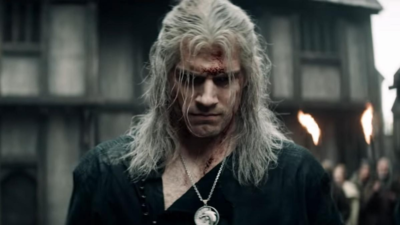
The Witcher Fest consisted of two main parts. First, there was an exhibition and an ongoing LARP-like quest for the fans, and then, the screening with a concert. In the meantime, the author of the Witcher Saga, Andrzej Sapkowski himself, came to sign the books and posters. But the queue was huge and the writer’s time was limited to 30 minutes, so I allowed myself to skip this part. And, to be honest, I don’t even own the physical copies of the Witcher books – I’ve only got e-books.

Then, I looked at the make-up section, where you could get some elf ears or a witcher-like scar on your face, and I went ahead through the portal to see the rest of the areas.
All of them were inspired by the places in the Witcher saga. In the Ruins, you could take a vanity photo with the big Witcher logo in the background. Then there was a big monster and stairs behind it which led to the Marshlands. These were quite spectacular: swampy, and wet, with two witchers guarding the track and a big Aeschna lurking behind them. The bestiary describing the most important monsters of the Continent was also in the area.

All these attractions were followed by the screening of the first two episodes from season free. I’ll reiterate what I’ve already said at the beginning – I really like the Netflix show. Yes, the adaptations of the short stories in season one varied when it comes to their quality (and I consider the short stories an absolute peak of Sapkowski’s Witcher writings). But the rest: Yennefer and Ciri’s backstories based on tidbits from the books and then significantly expanded upon, were, as far as I’m concerned, excellent. As was the second season. Yes, the events described in the saga were adapted quite loosely. The screenwriters added some new plot threads and embellished the original ones. However, it made the story from the first volume of the main saga, which was quite simple, more attractive, lively and dramatic. I really enjoyed Fringilla Vigo’s political intrigues and the addition of Voleth Meir was also quite interesting to watch. And I have got absolutely nothing against the things which the creators decided to do with Eskel, because, let’s be honest, he was not that prominent a character in the books anyway.

What I liked the most in the first episode was the way the relationship between Geralt and Yennefer was shown. At first, they are cold towards each other (as a consequence of what happened in season two), and then, gradually, they warm up to each other. And I absolutely loved the letters read off-screen which cleverly expanded upon their feelings.
The first episode was a foundation upon which the rest of the story will be built. The second one develops it further with a lot of intrigues (including spy plots), action and some scenes which the fans will likely recognise from the books. Yet again, much like in season two, the most fascinating are all the political shenanigans. I was sitting at the edge of my seat watching the schemes of Djikstra, Filippa Eilhart and Radovid, as well as the ones by Vilgefortz. We also visit Emhyr and Fringilla, and follow the freedom-fighting Scoia’tael. In the meantime, we, of course, spent a lot of time with Geralt, who is tracking Rience, and Yennefer and Ciri, who are heading to Aretuza – the same as it was in the books. What happens with Ciri is really interesting here as she gets to learn that even the smallest act always has got grave consequences. And I have to say that the episode ends with a mind-blowing plot twist which got me really intrigued for the rest of the season.

There was one more surprise after the screening: a performance by a folk metal band Percival, whose members contributed to this season’s score (as well as the third video game). As a musical freak, I was fascinated by their unusual instruments: a byzantine lyre, a long-necked lute and sopilka playing in harmony with a traditional cello and modern drums. They sounded beautiful together and the band members’ enthusiasm (especially its leader’s) added a lot of colour to the performance.
To sum up, the Witcher Fest was an amazing event for the fans. I hope the next seasons will also have these big celebratory fan fests – maybe I’ll manage to get there again 😉 And, of course, I can’t wait for the next episodes, which will release this Thursday. Will you be watching?









Leave a Reply